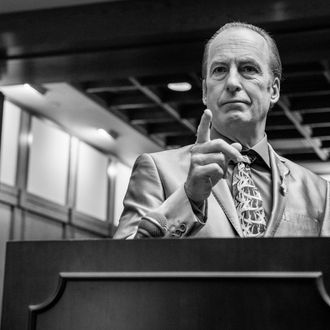
Better Call Saul came to an emotional end last night with “Saul Gone,” a finale that honored the journeys of both Jimmy McGill (Bob Odenkirk) and Kim Wexler (Rhea Seehorn), the latter of whom series creator and showrunner Peter Gould considers a “co-protagonist.” The finale also paid tribute to the characters of Breaking Bad, Better Call Saul’s parent show, featuring presumably final glimpses of Mike Ehrmantraut (Jonathan Banks), Walter White (Bryan Cranston), and even Marie Schrader (Betsy Brandt).
In a video press conference today, Gould, Odenkirk, and Seehorn unpacked the beautifully fitting conclusion to Better Call Saul, touching on the ways it “throws Breaking Bad and El Camino into a different light.” They also revealed a number of other potential endings that were considered, either sincerely or in jest, for the end of this decade-and-a-half-spanning story.
Jesse could’ve ended up in prison instead of Saul.
While Vince Gilligan was working on El Camino, Breaking Bad’s sequel film about Jesse, he pitched potential endings to the Better Call Saul writers’ room. One ending for Jesse was very similar to the ending Gould and the writers had in mind for Saul. “I just felt so strongly that the right ending for Saul was to be in the system, the system that he’s made light of and that he’s twisted around for his own purposes,” Gould said. “Hopefully Vince won’t be mad, but I think some of us, I especially, said, ‘What about another ending for Jesse?’ And I think the ending he came up with for Jesse was exactly the right one.”
Saul could’ve impressed the judge with his honesty and sent her to jail.
Odenkirk joked about his proposed ending: “After Saul makes his admission, the judge bangs her gavel and announces, ‘I’ve literally never seen anyone be so honest in my courtroom.’ Then she takes her robe off and puts it over Saul’s head and says, ‘Here, you sit here,’ and gives him $100, and she goes to jail. And the last scene is the judge in jail crying.” While it may not have been in the cards for Better Call Saul, it’s one that would’ve worked just fine for a Mr. Show sketch.
The final-season Gene episodes could’ve been in color.
The writers’ room decided around season four or five that the series would be returning to the post–Breaking Bad world of Gene Takavic, Saul’s alias when he went into hiding and became manager of a Cinnabon in Omaha. Prior to season six, all of Gene’s appearances were limited to season-opening flash-forwards, rendered in crisp black and white. But the writers initially considered switching to color for his final-season appearances, scared about having so much of the show in monochrome.
“But that really felt wrong,” Gould said. “It’s a little like Wizard of Oz. To go from black and white to color would’ve given the wrong feel to those scenes. So we took the plunge and said, ‘It’s all going to be black and white,’ and we didn’t get a single bit of pushback from the studio or the network.” In the end, the writers opted to allow only brief glimpses of color: the “Better Call Saul” ad reflected in Gene’s glasses to show his nostalgia for his Saul persona, and the lit cigarette to show that his relationship with Kim is now “the one bit of color in his world.” Speaking of which …
The visitation scene could’ve gone multiple ways.
One of the most unforgettable parts of “Saul Gone” is the penultimate scene, when Kim visits Jimmy in prison to share a cigarette — an interaction Odenkirk describes as “one of the few times that one of them isn’t trying to manipulate the moment [or] push some argument.” But when the writers originally broke the episode, the meeting happened in Albuquerque, before Jimmy went to prison — and the final scene was him alone in captivity. “It seemed a little cold,” Gould said. “I think ultimately, we all felt like ending with the two of them felt like the strongest way to go.”
That wasn’t the end of it, though. While Odenkirk described the scene as “the easiest scene we ever shot” because of the actors’ comfort with each other, the cigarettes they had to smoke posed some difficulty — Odenkirk and Seehorn were coughing, and Gould said he had cigarette smoke down his throat for days afterward. Early in editing, the scene’s place still wasn’t yet clear; at one stage, the visitation was the final scene, leaving out the prison-yard denouement. But in the end, “it felt more honest to end with the two of them apart rather than together,” Gould said.
Kim and Marie could (perhaps still?) have a buddy-cop spinoff.
Gould referred to Betsy Brandt, who reprised her role as the widow Marie Schrader in the finale, as one of his favorite people in the world. In fact, he said, in his dream world, there would be a Betsy Brandt–Rhea Seehorn buddy-cop TV series — an idea that triggered an immediate “I’m in!” from Seehorn. The Breaking Bad universe may have come to an end, but never say never.


